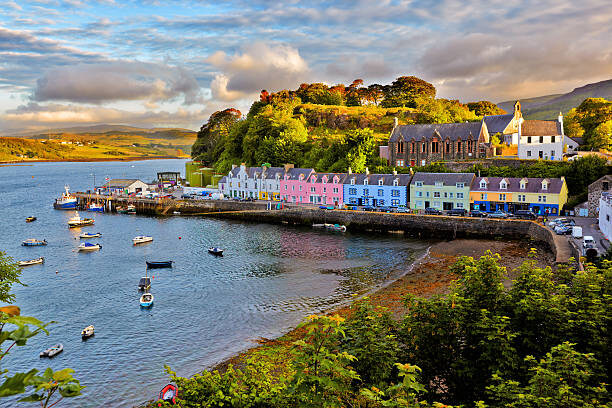Exploring the Enigmatic Cliffs of Scotland
Scotland, a land of captivating landscapes and storied history, is renowned for its breathtaking cliffs that stand as ancient sentinels, guarding the rugged coastlines and captivating the hearts of all who behold them. The Cliffs of Scotland, with their dramatic formations and sheer natural beauty, have long captured the imagination of adventurers, nature enthusiasts, and artists alike. From the iconic Cliffs of Moher to the lesser-known gems scattered along the coastline, these majestic cliffs offer a glimpse into Scotland’s rich geological heritage and provide a haven for a diverse array of flora and fauna.
A Glimpse into the Geological Marvels
Nestled along the western and northern fringes of Scotland, the Cliffs of Scotland are a testament to the geological forces that have shaped the region over millions of years. Carved by the relentless power of the crashing waves and shaped by the unforgiving winds, these cliffs boast an assortment of rock formations, including towering basalt columns, limestone ridges, and sandstone cliffs, each bearing the unique signature of Scotland’s tumultuous past. The renowned Cliffs of Moher, standing proudly along the Atlantic coast, are a prime example of this geological splendor, their towering heights offering panoramic vistas of the emerald-hued waters below.
Ecological Diversity Amidst the Cliffs
Beyond their geological significance, the Cliffs of Scotland also serve as vital ecosystems, fostering a diverse array of plant and animal life that have adapted to thrive amidst the rugged terrain and harsh coastal conditions. From hardy heathers and resilient grasses clinging to the cliff faces to seabirds swooping and diving in the updrafts, these cliffs offer a sanctuary for a myriad of species. The renowned puffins, with their distinctive beaks and comical waddles, find sanctuary in the crevices, while the majestic golden eagles soar above, casting their watchful gaze over the untamed landscape. The cliffs, with their precarious ledges and hidden caves, provide a sheltered haven for numerous species, making them an integral part of Scotland’s natural heritage.
The Historical Tapestry of Scotland’s Cliffs
Beyond their geological and ecological significance, the Cliffs of Scotland also hold a significant place in the tapestry of Scotland’s history and cultural heritage. These cliffs have witnessed the rise and fall of ancient civilizations, the ebb and flow of conquerors and kings, and the silent whispers of countless tales woven into the fabric of Scotland’s folklore. The iconic Dunnottar Castle perched atop the towering cliffs, once a formidable stronghold and now a hauntingly beautiful ruin, stands as a testament to Scotland’s tumultuous past, evoking a sense of awe and nostalgia in all who visit.
A Haven for Adventure Seekers and Wanderers
For the adventurous at heart, the Cliffs of Scotland offer a myriad of exhilarating experiences and thrilling escapades. From heart-pounding cliff-top hikes offering panoramic views of the boundless sea to adrenaline-inducing rock climbing expeditions challenging even the most experienced climbers, these cliffs provide an unparalleled playground for those seeking an adrenaline rush amidst nature’s raw grandeur. The coastal trails winding along the cliffs beckon hikers and explorers, promising unforgettable vistas and a profound connection with the untamed wilderness that defines Scotland’s rugged charm.
The Timeless Allure of Scotland’s Cliffs
Every season, under the ever-changing Scottish skies, the Cliffs of Scotland exude a timeless allure that transcends the confines of time and space. The mists that shroud the cliffs in an ethereal embrace, the waves that crash against the rugged shores with a relentless rhythm, and the ever-present whispers of history that permeate the air all contribute to the mystical charm that envelops these majestic cliffs. As the sun sets, casting its warm hues across the horizon, and the cliffs bask in the soft twilight glow, one can’t help but be captivated by the sheer magnificence of Scotland’s natural wonders.
Understanding the Geological Formation of Scotland’s Cliffs
The geological formation of the Cliffs of Scotland is a result of complex processes spanning millions of years. The Scottish cliffs are primarily composed of various rock types, including basalt, sandstone, and limestone, each contributing to the distinct features and formations observed along the coastline. Basalt, a volcanic rock, often forms hexagonal columns, creating unique patterns that are visible in some of Scotland’s prominent cliffs. Sandstone cliffs, on the other hand, are known for their distinctive red and brown hues, adding a vibrant touch to the rugged landscape. Limestone formations, characterized by their smooth surfaces and intricate patterns, contribute to the diverse geological tapestry that defines Scotland’s cliffs.
The Significance of Scotland’s Cliffs in Biodiversity Conservation
The Cliffs of Scotland play a pivotal role in the conservation of Scotland’s rich biodiversity. These cliffs provide crucial habitats for various plant and animal species, some of which are uniquely adapted to the harsh coastal conditions. The diverse flora found along the cliff faces includes resilient grasses, wildflowers, and mosses that have evolved mechanisms to withstand strong winds and saline spray. Seabirds, such as puffins, guillemots, and razorbills, find sanctuary in the crevices and nesting sites of the cliffs, forming thriving colonies that contribute to the region’s ecological balance. The conservation efforts directed towards preserving the fragile ecosystems of Scotland’s cliffs are essential for maintaining the delicate balance of the region’s natural heritage.
Unraveling the Myth and Legend Surrounding Scotland’s Cliffs
Scotland’s cliffs have long been intertwined with a rich tapestry of myths, legends, and folklore that have shaped the cultural identity of the region. These cliffs, with their imposing heights and enigmatic presence, have often been the subject of ancient tales, evoking a sense of mystery and wonder among those who have long been captivated by their allure. From stories of mythical creatures dwelling within the hidden caves to legends of valiant warriors defending their kingdoms atop the precipitous cliffs, the folklore surrounding Scotland’s cliffs continues to fascinate and enchant visitors from around the world. The enduring presence of these myths serves as a testament to the profound connection between Scotland’s natural landscapes and the imaginative spirit of its people.
Sustainable Tourism Practices for the Preservation of Scotland’s Cliffs
As the popularity of Scotland’s cliffs continues to soar, the implementation of sustainable tourism practices has become imperative for the preservation of these natural wonders. Sustainable tourism initiatives, such as responsible visitor guidelines, waste management strategies, and conservation-focused education programs, play a vital role in minimizing the ecological impact of tourism activities on the delicate ecosystems of the cliffs. Encouraging responsible behavior among visitors, promoting awareness about the fragility of the natural environment, and supporting local conservation efforts are essential steps in ensuring the long-term preservation of Scotland’s cliffs for future generations to admire and cherish.
Exploring the Cultural Heritage Along Scotland’s Cliffs
The cultural heritage intertwined with Scotland’s cliffs extends far beyond their geological and ecological significance. These cliffs have served as inspirational backdrops for countless works of art, literature, and music, reflecting the profound impact of their majestic beauty on the creative endeavors of individuals throughout history. The haunting allure of the cliffs has inspired renowned poets and writers, such as Sir Walter Scott and Robert Burns, to craft timeless verses that capture the essence of Scotland’s rugged charm. Furthermore, the rich cultural traditions and customs of the local communities nestled along the cliffs’ coastline add a vibrant touch to the narrative, enriching the tapestry of Scotland’s cultural heritage with each passing generation.
People also read
Backpacking Spain: Your Ultimate Guide to an Unforgettable Adventure
The Worst Time to Visit Spain: Navigating the Seasonal Maze
Beach Club Nice: A Paradise by the Sea
Promoting Environmental Awareness and Conservation Efforts
In the face of increasing environmental challenges, promoting environmental awareness and conservation efforts remains paramount in safeguarding the Cliffs of Scotland for future generations. Collaborative initiatives between governmental bodies, environmental organizations, and local communities are instrumental in raising awareness about the fragility of Scotland’s natural ecosystems and the importance of preserving the region’s biodiversity. Implementing sustainable practices, advocating for the protection of endangered species, and fostering a sense of environmental stewardship among the public are crucial steps in fostering a collective commitment to the long-term conservation of Scotland’s cliffs and the irreplaceable natural heritage they embody.
Concluding Thoughts
In essence, the Cliffs of Scotland stand as a testament to the enduring power of nature, the rich tapestry of history, and the unyielding spirit of adventure that defines the Scottish landscape. From their geological marvels to their ecological diversity, from their historical significance to their allure for adventure seekers, these cliffs encapsulate the very essence of Scotland’s enchanting beauty. As travelers and enthusiasts continue to flock to these mesmerizing cliffs, they bear witness to the profound connection between land and sea, between past and present, and between the intangible spirit of Scotland and the enduring majesty of its cliffs. Through sustainable preservation efforts and an unwavering commitment to environmental conservation, the timeless allure of the Cliffs of Scotland can continue to inspire and captivate generations to come, serving as a poignant reminder of the irreplaceable wonders found within Scotland’s pristine natural landscapes.




